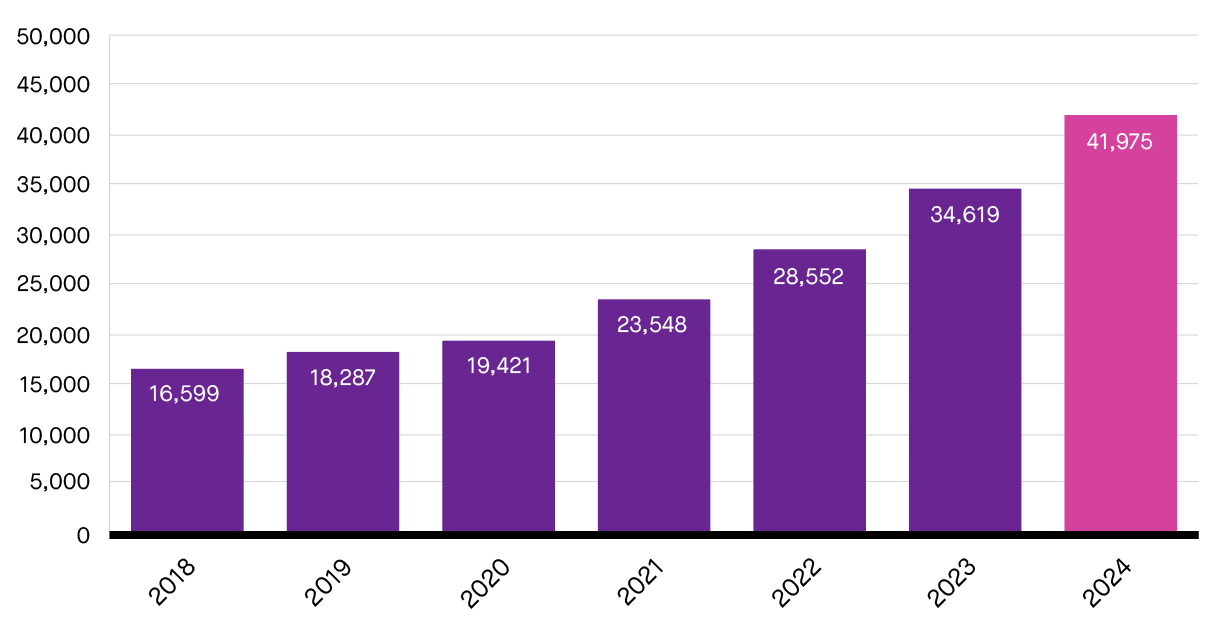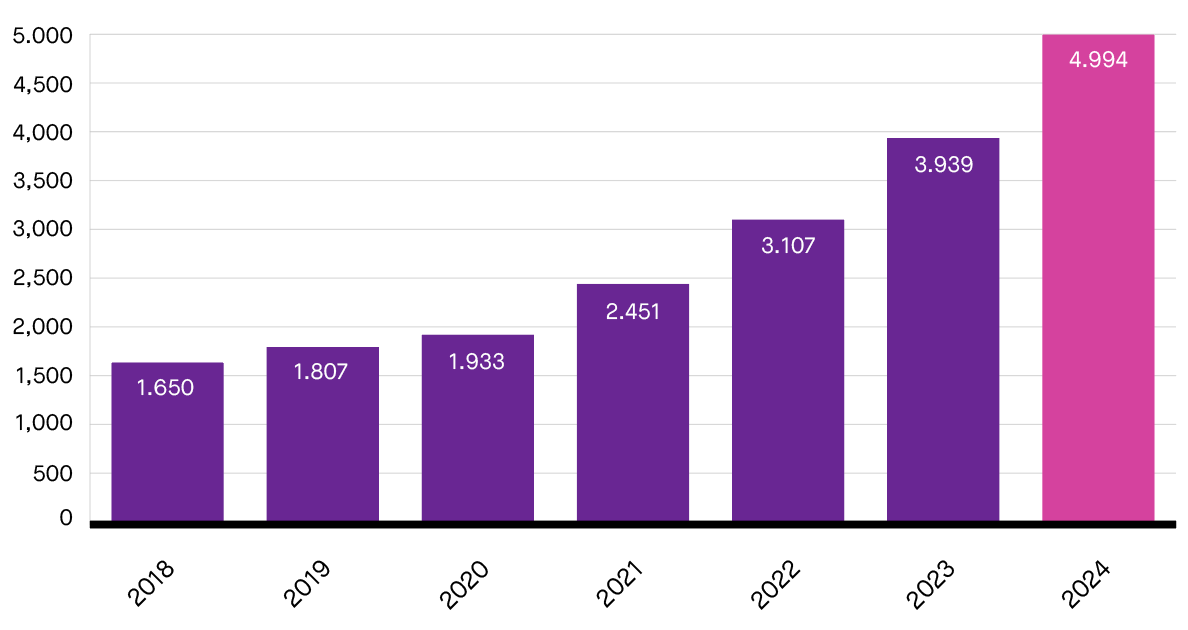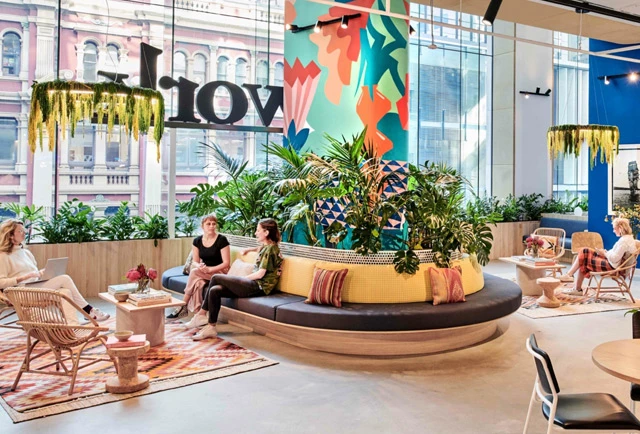- 3 Minute Read
- 21st October 2021
The global flexible workspace industry is set to grow by $13.35Bn in the next five years
There are now over 20,000 flexible workspaces worldwide and that number is expected to double by 2024. Industry experts are predicting an annual growth rate of over 21% over the next three years. The value of the global flexible workspace market is estimated to be around $26Bn and is set to grow by $13.35Bn through to 2025.
Despite the short-term impacts of COVID-19 the industry expects to grow and thrive in the post pandemic world. In the UK, the flexible workspace market is set to hit 12.5% penetration of the office market in the next two years, doubling the current supply. The office will continue to play an important role in the future of work. In February of 2021 PWC reported that 72% of workers wanted hybrid working, mixing remote and in-person office work.
In this article we look at some of the latest headline statistics surrounding the global flex market and highlight the key reasons why more and more organisations are turning to a flexible workspace solution for their office requirements.
What is a flexible workspace?
Flexible workspace is a popular flexible alternative to traditional office leasing. Flexible workspace is an umbrella term used to describe office space that covers a variety of versatile office space solutions such as hot desks, coworking, serviced offices and managed offices.
Flex spaces can be rented short term on rolling monthly contracts. They are fully furnished, ready to move into, and rental agreements often cover periods from a month to two years or more.
42,000 flexible workspaces worldwide by 2024
Number of global flexible workspaces


Source: Coworking Resources / Coworker
Between 2020 and 2024 the number of flexible workspaces worldwide is expected to double. The impact of COVID-19 in 2020 slowed the rate of growth to 6.2% but the market is expected to bounce back this year to record 21.3% year on year growth.
5 million people using flexible workspace by 2024
Number of people using flexible workspaces (Millions)


Source: Coworking Resources / Coworker
Nearly 2.5M people are expected to be working in flexible workspaces by the end of 2021 and that number is predicted to double over the next three years. Whilst the pandemic has kept many office workers away from their desks, as restrictions ease, vaccinations roll out and staff return to the office, flexible workspaces will see steady growth in usage.
The reasons why flexible workspace is set to grow

1. Corporate demand for flex space
The quality and supply of flexible workspace have dramatically increased in recent years. Corporates now view flexible workspace as a viable alternative to traditional leasing. The pandemic has accelerated corporate demand for flexibility.
2. Hybrid working
As a result of the pandemic more companies are embracing hybrid working, where staff split their time between office and remote work. Flexible workspace is the ideal solution to accommodate flexible workpatterns.
3. Suburban and secondary market growth
The supply of flexible workspace has greatly increased in non-core city locations and since the pandemic, demand has grown for less dense, smaller and more convenient secondary locations.
4. New operating models
Traditional landlords are now developing flexible operating models to meet demand for flexible workspace. Examples include British Land’s Storey and Landsec’s MYO.
5. The emergence of niche operators
Flexible workspaces have emerged to attract and support like-minded communities. You can find flexible workspace exclusively for groups such as artists, engineers, programmers, musicians, chefs and many more.
The key reasons why corporate businesses love flexible workspace

At Office Freedom we have been helping more corporate and enterprise clients than ever find suitable flexible workspace. In every instance, much like our client YouGov, clients reference one or more of the following motivations for seeking flexible workspace.
Financial – Moving into flexible workspace can reduce capital expenditure, cut overheads and provide operational financial certainty. By reducing long term office commitments organisations can reduce balance sheet liability and improve the efficiency of capital.
Agility – In volatile markets organisations can face unpredictable or dynamic changes in headcount. Flexible workspaces make it easy to expand or contract space as required, building in agility.
Operational efficiency – Having a single supplier for all workspace operations creates operational efficiencies and reduces the administrative burden.
Business evolution – Mergers and acquisitions, exploring new territories, new ventures, project work and other business decisions can all act as triggers to utilise flexible workspace.
Speed of occupancy – Flexible workspaces are available on short lead times. Existing spaces are available for immediate occupation and bespoke managed spaces can usually be delivered faster than in-house projects.
Employee engagement – The quality of workspace and the range of facilities and amenities on offer in a flexible office may be hard to match. The flexible office environment can foster staff wellbeing and aid staff recruitment and retention.
A bright future for flexible workspace

According to industry studies, 67% of business decision makers are increasing workplace mobility programmes and are incorporating flexible workspace as a central component of their agile work strategies. 86% of respondents see flexible workspace as a key component of their future real estate strategies. An overwhelming 90% of respondents predicted that lease flexibility will increase in the future and of these, a quarter believed this would take the form of flexible workspace.
In a world where uncertainty and unpredictability has become the norm, businesses require flexibility and agility in their workspace strategy. The flexible workspace sector is best equipped to fulfil that need and looks set for strong growth in the coming years.
Search and compare the entire flexible office market here.
